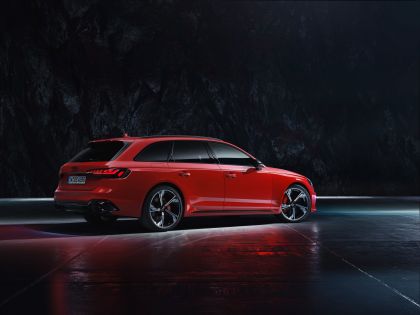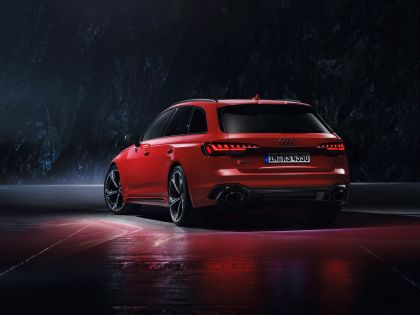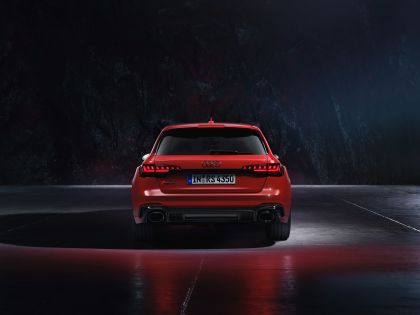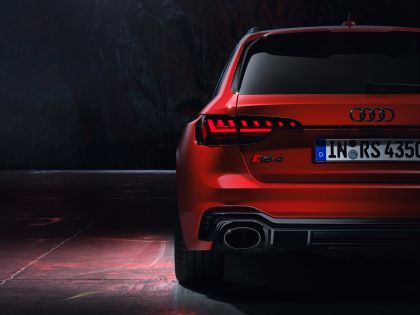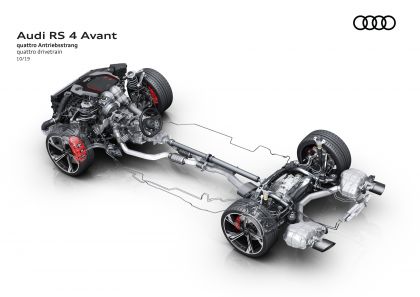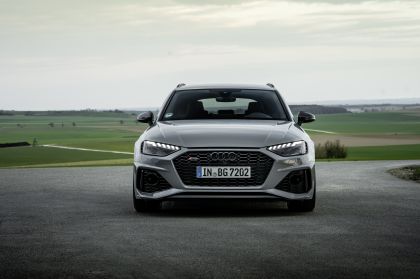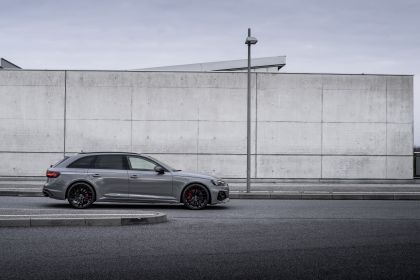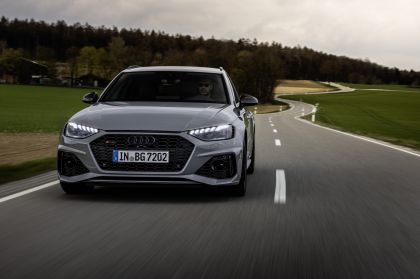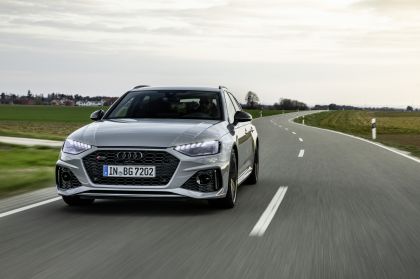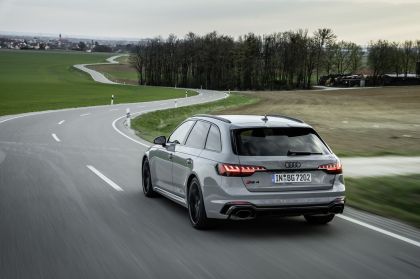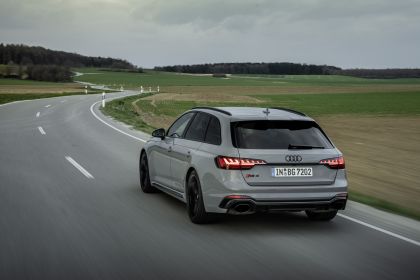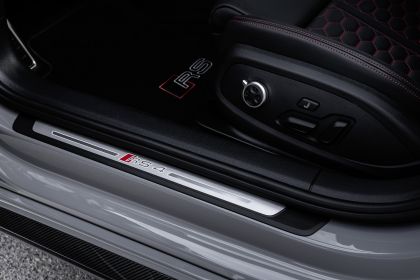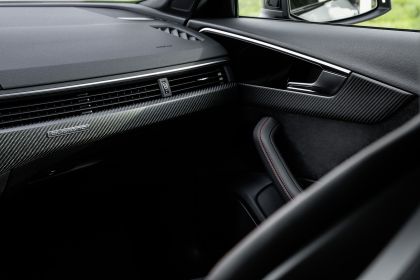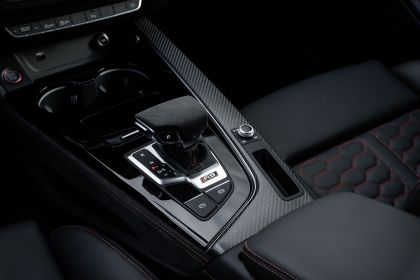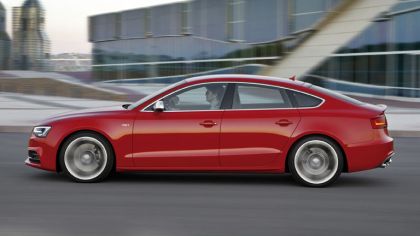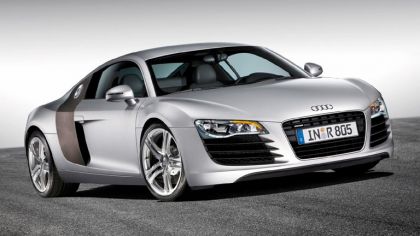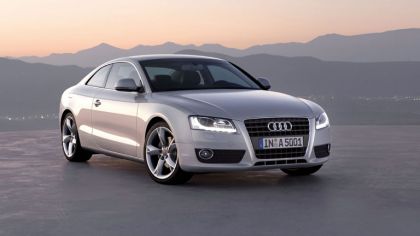The Audi Sport GmbH has fine-tuned many details of the Audi RS4 Avant which was newly introduced in September 2017. The newly designed front section and the sporty interior with the new MMI touch operating system underline the athletic aspirations of the success model, which has a legendary line of ancestors. The high-torque twin-turbo V6 with a power output of 331 kW (450 metric hp) applies an impressive 600 Nm (442.5 lb-ft) of torque to the crankshaft in a broad engine speed range from 1,900 to 5,000 rpm. The RS4 Avant will make its debut at the DTM finale at the Hockenheimring on 4 to 6 October 2019. Sales in Germany and other European countries will start in October 2019. The new Audi RS4 Avant will be at dealerships as of December 2019. Prices for the high-performance Avant start at EUR 81,400.
"Combining consistent sportiness with unlimited everyday usability may seem like an unconventional idea to some, but to us, the high-performance Avant is one of the best concepts of our 25-year history," says Oliver Hoffmann, Managing Director of Audi Sport GmbH. "As our long-standing bestseller, the Audi RS4 Avant contributes significantly to the success of Audi Sport GmbH."
Muscular: the exterior design
The front section of the new Audi RS4 Avant was completely redesigned. The RS4 Avant differs considerably from the A4 Avant. The Singleframe is wider and flatter as compared to the base model. Just like its big RS brothers, the RS6 Avant and the RS7 Sportback, the RS4 Avant also features the three-dimensional honeycomb structure in gloss black that is typical for the RS model series. To give it a clean look, the Singleframe is designed without a frame. The new eggcrate grille with the RS4 emblem is inserted directly into the bumper with the large lateral air inlets and vertical flaps.
The shape of the LED headlights of the Audi RS4 Avant has also been redesigned. The optional matrix LED headlights with darkened bezels complete the revised appearance of the high-performance Avant and differentiate it within the A4 family. The wheel arches with the quattro blisters located above are each 30 millimeters (1.2 in) wider at the front and back as compared to the Audi A4 Avant. Gloss black design elements positioned right next to the headlights underline the effect of width of the new RS4 Avant.
The gloss black, matt aluminum and carbon styling packages add individual accents to the inlay in the sill, the exterior mirror housings and the front and rear bumpers. Upon request, the gloss black and carbon styling packages also include the Audi rings and the RS logo in black on the front and rear. The RS badges can be omitted completely for a more understated look. The roof rails are designed in matt black as standard. The RS-specific roof edge spoiler and the diffuser insert as well as the chrome tailpipes of the RS exhaust system give the vehicle a distinct finish. The optional RS sport exhaust system with black tailpipe trims creates a particularly sporty sound experience. The driver can decide whether they want a sporty or subdued sound via the Audi drive select dynamic handling system.
Full tractive power: the drive
With the 2.9 TFSI twin-turbo V6, Audi Sport GmbH is building on the legendary 2.7 liter V6 of the first RS4 Avant from 1999. Back then, the twin-turbo V6 had a power output of 279 kW (380 metric hp). The new Audi RS4 Avant now outputs 331 kW (450 metric hp), which equals an output of 155.5 metric hp per liter. This allows the RS4 Avant to accelerate from zero to 100 km/h (62.1 mph) in just 4.1 seconds. The TFSI engine weighs just 182 kilograms (401.2 lb), which is 31 kilograms (68.3 lb) less than the V8 engine in the predecessor model from 2012. This benefits the gross weight and the axle load distribution-two prerequisites for the impressive performance. The twin-turbo V6 applies an impressive 600 Nm (442.5 lb-ft) of torque to the crankshaft in a broad engine speed range from 1,900 to 5,000 rpm. The RS dynamic package increases the electronically governed top speed from 250 to 280 km/h (155.3 to 174.0 mph).
The two turbochargers of the 2.9 TFSI are each assigned to a cylinder bank and build up a boost pressure of up to 1.5 bar. Like with all V6 and V8 engines from Audi, the turbochargers are installed within the 90-degree interior "V" of the cylinder banks, and thus the exhaust side of the cylinder heads is on the inside, while the intake side is on the outside of the engine. This layout enables compact construction and short gas flow paths with minimal flow losses, allowing the 2.9 TFSI to respond particularly spontaneously to movement of the accelerator pedal.
The high-output V6 impresses not only with its strong performance but also with its high level of efficiency. In the new WLTP driving cycle, it consumes just 9.2 liters of fuel per 100 kilometers (25.6 US mpg), which corresponds to 208 grams of CO2 per kilometer (334.7 g/mi). This constitutes a consumption reduction by 17 percent as compared to the previous model. A decisive factor in this is the new TFSI combustion process from Audi, which is known as the B-cycle. It has been specifically designed for the partial-load range, which is the predominant operating mode during normal use. In the case of higher loads and rotational speeds, the two-stage Audi valvelift system (AVS) closes the intake valves later, thereby increasing the opening duration to a crank angle of 200 degrees. Simultaneously, valve lift increases from 6.0 to 10 millimeters (from 0.2 to 0.4 in). The cylinder charge thereby increases accordingly-the engine revs up powerfully and delivers an opulent output.
The power of the 2.9 TFSI flows to the quattro permanent all-wheel drive system via the sporty eight-speed tiptronic. In regular driving, the system delivers more power to the rear axle. Its purely mechanical center differential directs 60 percent of the torque to the rear axle and 40 percent to the front. If undesired slip occurs at one axle, most of the power is automatically and rapidly redirected to the other axle-up to 70 percent to the front or up to 85 percent to the rear axle. The high locking values enable a clearly defined torque distribution and highly precise interaction with the control systems of the ESC and wheel-selective torque control.
Wheel-selective torque control is active on all types of surfaces. When driving with a sporty style, it brakes the the wheels on the inside of the curve very slightly via the Electronic Stabilization Control (ESC), thereby increasing the drive torque on the wheels on the outside of the curve with the higher wheel load. The difference in drive forces turns the car into the bend, allowing the car to follow the steering angle precisely. The result: precise, agile and neutral handling. The optional quattro sport differential with RS-specific tuning ensures an even more dynamic response when accelerating in corners. It distributes the torque between the rear wheels actively and in a targeted manner, thereby improving traction, stability and dynamics. When turning or accelerating in a curve, the torque is predominantly steered toward the rear wheel on the outside of the curve-the car is literally pressed into the curve, eliminating even the slightest hint of understeer. In case of oversteer, the sport differential stabilizes the vehicle by directing torque to the wheel on the inside of the curve.
Sporty tuning: the suspension
The axle concept of the suspension with five-link suspensions at the front and rear enables the optimal absorption of longitudinal and lateral forces. With the standard RS sport suspension, the Audi RS4 Avant is seven millimeters (0.3 in) lower than the S4 base model with sport suspension.
The RS sport suspension plus with Dynamic Ride Control (DRC) enables even more agile handling and is available upon request. This integrated roll and pitch stabilizer consists of a special damper system that counteracts the movements of the vehicle body with no delay without the use of electronics. When the vehicle is turning into and traveling around a bend, the damper response is altered so that the vehicle's movements around the longitudinal axis (roll) and around the transverse axis (pitch) are significantly reduced. The dampers are each connected diagonally to a central valve via two separate oil lines. The valves provide the necessary compensating volume via internal pistons with the gas-filled compartment behind them. When the vehicle is steering into and traveling around a bend, an oil flow is generated between the diagonally opposite dampers via the central valve, thus creating additional damping force. When one side is cushioned, the damping characteristics are altered such that roll and pitch movements are almost eliminated. As a result, this highly responsive damper system ensures that the RS models are particularly precise when negotiating bends.
With the aid of Audi drive select, the driver can influence the damper response on three levels and thereby personalize the driving experience. The new generation of dampers with integrated valve is more compact and lighter. In addition, it enables the damping forces to be spread even more widely between the comfort and dynamic modes as well as more precise suspension adjustment for high damping forces, which occur when cornering at speed in particular. The result: The RS sport suspension with Dynamic Ride Control (DRC) ensures a markedly comfortable rolling motion in the "comfort" setting. In the "dynamic" program, it delivers extraordinarily taut driving precision even when cornering at high speed.
RS-specific dynamic steering is available as an alternative to the standard electromechanical power steering. Dynamic steering varies the steering ratio by up to 100 percent based on the driving speed, steering angle and selected mode in the Audi drive select handling system. At low driving speeds-in city traffic and in maneuvering-the dynamic steering operates very directly; all it takes is two full turns of the steering wheel to travel from end stop to end stop. The level of power assistance is also high, making parking maneuvers a piece of cake. On country roads, the directness of the steering response and electric power assist are reduced progressively. When driving at high speeds on the highway, the indirect gear ratio and low level of power assistance smooth out jerky steering movements and assist with confident directional stability. Dynamic steering works closely with the electronic stabilization control program (ESC) to achieve sporty handling and driving safety. If necessary, it counter-steers slightly; its slight corrections, most of which are unnoticeable to the driver, reduce understeer and oversteer due to load alterations in the vast majority of situations. When braking on road surfaces with different friction coefficients, the system helps by means of stabilizing steering corrections.
The driver can create their personal driving experience via the standard Audi drive select dynamic handling system. There are five profiles available: comfort, auto, dynamic and the customizable, RS-specific RS1 and RS2 modes. The Audi drive select dynamic handling system influences the engine and transmission management, the power steering, the suspension, the dynamic steering, the quattro sport differential, the engine sound and the characteristics of the automatic air conditioning. The customizable RS2 mode exists specifically to influence the Electronic Stabilization Control (ESC) quickly at the push of a button.
The new Audi RS4 Avant is factory-equipped with 19-inch forged aluminum 265/35 wheels. Various 20-inch designs are available upon request, including a new fully milled five-arm wheel painted completely in matt bronze. It uses 275/30 tires. Powerful RS steel brakes with perforated composite disks ensure confident deceleration behavior. They have a diameter of 375 millimeters (14.8 in) at the front axle and 330 millimeters (13.0 in) at the rear axle.
The six-piston brake calipers with RS logos are painted in black, or optionally in red. Upon request, particularly fade-resistant RS ceramic brakes operate at the front axle. The calipers are available in red, gray and blue. Their perforated disks have a diameter of 400 millimeters (15.7 in).
Connected cockpit: the interior
The Audi RS4 Avant features a black interior. LED light guides trace the contours of the doors and the center console-doing so in up to 30 different colors in combination with the optional ambient lighting package. The horizontal alignment of the instrument panel creates a sense of spaciousness. The driver and front passenger are welcomed by the illuminated door sill trims that bear the RS4 logo. Upon request, the RS design package adds some color to the interior, with the RS logo featured on the center console, the armrests, seat belts and floor mats. The steering wheel, selector lever and knee pads are all covered with Alcantara with red contrasting stitching. In addition to the red, the extended RS design package now also offers accents in gray. As a new highlight for the RS design package in red, the seat brackets in the backrest are also available in the matching color.
The 10.1-inch MMI touch display is the control center of the new operating system. It is located in the center of the instrument panel and tilted slightly toward the driver. The touch-sensitive screen displays a high-resolution graphic animation of an RS4 Avant to welcome the driver. The MMI touch display provides acoustic feedback and takes over the functions of the previous rotary pushbutton on the center console. The driver can use the RS monitor to call up an overview of drive system component temperatures, maximum g-forces and information regarding tire pressures and temperatures. In the Audi virtual cockpit, special RS displays provide information on tire pressure, torque, power output, engine oil temperature, lap timings, acceleration measurements and g-forces. The shift light display prompts the driver to upshift when the rev limit is reached. The optional head-up display also providers some RS-specific information, for example the shift light display.
With its strict hierarchies, the menu structure of the new operating system is tailored to the user's expectations and aims for easy operation. The natural language control also understands many phrases used in everyday language and quickly translates them into commands. The navigation in the new Audi RS4 Avant is now even more versatile and user-friendly. Audi connect and Audi connect plus provide a host of online services, such as Car-to-X services, which take advantage of the swarm intelligence of the Audi fleet.
The driver can actuate the two RS1 and RS2 modes in Audi drive select directly via a new "RS MODE" button on the flat-bottomed RS multifunction sport leather steering wheel. This automatically opens the RS-specific displays in the Audi virtual cockpit. The new aluminum shift paddles are considerably larger than before. Aside from the steering wheel and the illuminated door sill trims, the RS sport seats with optional honeycomb pattern and the shift gate also bear the RS emblem.
Versatile: the equipment
The RS4 Avant provides the same level of everyday usability as the A4 Avant base model. The luggage compartment has a capacity of 495 liters (17.5 cu ft), which increases to 1,495 liters (52.8 cu ft) with the rear seats folded down and cargo loaded to the roof. The luggage compartment lid and the luggage compartment cover are electrically operated as standard. Sensor control for opening and closing the luggage compartment lid is available as an option, and a trailer towing hitch that can be unlocked electrically at the push of a button is also available upon request.
Upon request, the Audi RS4 assists the driver in many situations: More than 30 driver assist systems underline the all-round characteristics of the high-performance Avant. The options are summarized in the "tour" and "city" packages. They include the adaptive cruise assist with stop & go function for automatic distance control, the intersection assist, the lane change warning or the curb warning.
Customers of the RS4 Avant can select from eight paint colors, including the new plain color Turbo blue and the new metallic color Tango red. The Audi exclusive program also includes many more customized paint finishes, for example Nogaro blue, pearl effect. This color already characterized the RS2 Avant as the legendary forefather of all RS models back in 1994.































